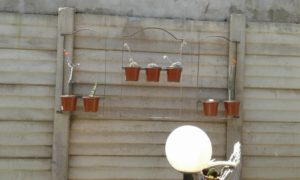Have you ever wondered what a “truly green” garden looks like? The eco-friendly, water saving, environment protecting type of superhero garden?
Yes? I thought so – today we will go over 4 simple steps you can take to make your garden more eco-friendly!
1. Recycle and Reuse old Materials
The main environmental concern is actually not your garden itself, but the material you use for the structures in your garden. Using recycled materials, especially plastics or reusing old wooden pallets, is a great way to go green.
For our worm bins, for instance, we reuse old wooden crates and pallets as well as plastic containers – much better in our garden than on a dumping site!
And as a bonus, reusing materials not just eco-friendly, it also gives you the chance to be more creative with your garden design and add some character to your garden some.
So always be on the lookout for “junk” that you can use in your garden and get innovative! Just take a look at what this passionate Namibian did:

2. Stop using the “Wrong” Soil
Yes, you heard correctly! Eco-unfriendly soil is actually a thing!
The problem is that most composts out there are unfinished. They are not fully decomposed and therefore not that helpful for the plant. In some cases, they are even harmful to soil and groundwater.
Same counts for manure. I know, I know – manure is cheap and “gets the job done”. That’s what many people think. The use of non-composted manure in agriculture is actually one of the biggest environmental problems out there!
“Good” composts and also Vermicompost, on the other hand, hold MANY benefits. They fertilize your ground sustainably and soak up water like a sponge, too.
A great compost should have almost a black color, it should be fairly moist and have an earthy smell to it.
Same accounts for Vermicompost – this natural fertilizer is produced by worms and is power packed with nutrients and the important microorganisms.
Always make sure to use compost in your garden that is “finished” and was produced in an eco-friendly way!
3. Save water
It’s probably needless to say how important water conservation is for a sustainable garden. ESPECIALLY in a country like Namibia, this is absolutely crucial!
If you have space, definitely consider getting a rain tank. Larger ones can easily collect enough water for the average garden – that also helps out your water bill!
Also, a clever, cost-cutting irrigation system helps too. Don’t use a sprinkler on the garden – most of that water is collected on the plant’s leaves and evaporate. Rather water the roots of plants with a dripping system.
Or something I recently came across that REALLY blows my mind – wicked beds!
That’s a special type of raised bed that can save up to 80% of water! All while making your plants grow even faster! I will DEFINITELY write about how to create your own soon!
4. No more Chemicals
I absolutely LOVE spraying harmful, toxic chemicals all over my garden, said NO PASSIONATE GARDENER EVER!
Believe it or not – there are MANY methods out there to keep insects and bugs from feasting on your beloved garden.
You cannot just save some money here, but you can truthfully say that your garden is ALL NATURAL!
There is a great article here where you can read up all kinds of helpful strategies.I know most of you need a solution to this problem. Gabi and I are currently working on a natural insect repellent. So hopefully that will be ready soon!
Also, I will write a blog post specifically about pests in Namibia and how to fight them very soon as well! So stay tuned!
That’s it…
So, here you have some simple 4 Steps you can do to turn your garden into a healthy and natural superhero! As you know, not all gardens are created equal, so make sure yours is of the right type!
Next time I will show you how you can build your own wicked bed from scratch – so stay tuned!


Recent Comments